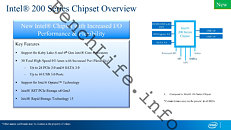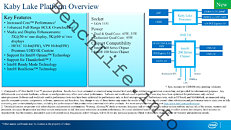- Joined
- Oct 9, 2007
- Messages
- 47,769 (7.42/day)
- Location
- Dublin, Ireland
| System Name | RBMK-1000 |
|---|---|
| Processor | AMD Ryzen 7 5700G |
| Motherboard | Gigabyte B550 AORUS Elite V2 |
| Cooling | DeepCool Gammax L240 V2 |
| Memory | 2x 16GB DDR4-3200 |
| Video Card(s) | Galax RTX 4070 Ti EX |
| Storage | Samsung 990 1TB |
| Display(s) | BenQ 1440p 60 Hz 27-inch |
| Case | Corsair Carbide 100R |
| Audio Device(s) | ASUS SupremeFX S1220A |
| Power Supply | Cooler Master MWE Gold 650W |
| Mouse | ASUS ROG Strix Impact |
| Keyboard | Gamdias Hermes E2 |
| Software | Windows 11 Pro |
Intel's tick-tock product development cycle is disturbed. The cadence of launching a new CPU microarchitecture on a given silicon fab process, miniaturizing it to a smaller fab process, and then launching an even newer micro-architecture on that process; is about to change with the company's 7th generation Core "Kaby Lake" processor. When launched, it would be the third microarchitecture built on the company's 14 nm process, besides "Skylake" (current new architecture) and "Broadwell" (miniaturization of "Haswell" to 14 nm.) Some of the very first documents related to Kaby Lake began to move about, making news along the way. The architecture is scheduled to launch along with its companion 200-series chipset some time in 2016.
To begin with, Core "Kaby Lake" will continue to be built on the LGA1151 package, and will likely be backwards compatible with existing 100-series chipset motherboards with a firmware update. From what we get to understand from leaked material, it will not be a vastly newer architecture than Skylake, at least not of the kind Skylake was to Broadwell. There are still CPU performance enhancements on offer, an "enhanced full-range BClk overclocking," which could mean improved overclocking on chips with upwards-locked multipliers (although we won't get our hopes too high and call it a return of the BClk overclocking era). A bulk of the R&D will fall into improving the integrated graphics, to support multiple 5K displays, 10-bit HVEC and VP9 hardware-acceleration; platform-integrated Thunderbolt 3, and platform interface support for Intel Optane (3D XPoint memory).


Like its predecessor, "Kaby Lake" will feature an integrated memory controller that supports both DDR4 and DDR3 memory. It will support faster DDR4-2400 natively; and DDR3L-1600. DMI 3.0 (physical PCI-Express 3.0 x4) will continue to be the chipset bus. The 200-series chipset, codenamed "Union Point," in its topmost variant, will feature native support for Intel Optane SSDs, and will feature greater port-flexibility among its downstream PCIe lanes. It will feature Rapid Storage Technology support for PCIe storage devices. By the time it launches, NVMe will achieve greater presence in the market.
Since it will be built on the existing 14 nm process, TDP of "Kaby Lake" chips will be similar to existing "Skylake" ones - 35W and 65W for dual- and quad-core desktop chips; with 95W for enthusiast-K variants of the desktop chips. Elsewhere in the lineup, there will be 8 top-level variants of "Kaby Lake," four of which will launch in Q3-2016, and four in early-2017, as incremental lineup upgrades.
View at TechPowerUp Main Site
To begin with, Core "Kaby Lake" will continue to be built on the LGA1151 package, and will likely be backwards compatible with existing 100-series chipset motherboards with a firmware update. From what we get to understand from leaked material, it will not be a vastly newer architecture than Skylake, at least not of the kind Skylake was to Broadwell. There are still CPU performance enhancements on offer, an "enhanced full-range BClk overclocking," which could mean improved overclocking on chips with upwards-locked multipliers (although we won't get our hopes too high and call it a return of the BClk overclocking era). A bulk of the R&D will fall into improving the integrated graphics, to support multiple 5K displays, 10-bit HVEC and VP9 hardware-acceleration; platform-integrated Thunderbolt 3, and platform interface support for Intel Optane (3D XPoint memory).


Like its predecessor, "Kaby Lake" will feature an integrated memory controller that supports both DDR4 and DDR3 memory. It will support faster DDR4-2400 natively; and DDR3L-1600. DMI 3.0 (physical PCI-Express 3.0 x4) will continue to be the chipset bus. The 200-series chipset, codenamed "Union Point," in its topmost variant, will feature native support for Intel Optane SSDs, and will feature greater port-flexibility among its downstream PCIe lanes. It will feature Rapid Storage Technology support for PCIe storage devices. By the time it launches, NVMe will achieve greater presence in the market.
Since it will be built on the existing 14 nm process, TDP of "Kaby Lake" chips will be similar to existing "Skylake" ones - 35W and 65W for dual- and quad-core desktop chips; with 95W for enthusiast-K variants of the desktop chips. Elsewhere in the lineup, there will be 8 top-level variants of "Kaby Lake," four of which will launch in Q3-2016, and four in early-2017, as incremental lineup upgrades.
View at TechPowerUp Main Site



 .
.